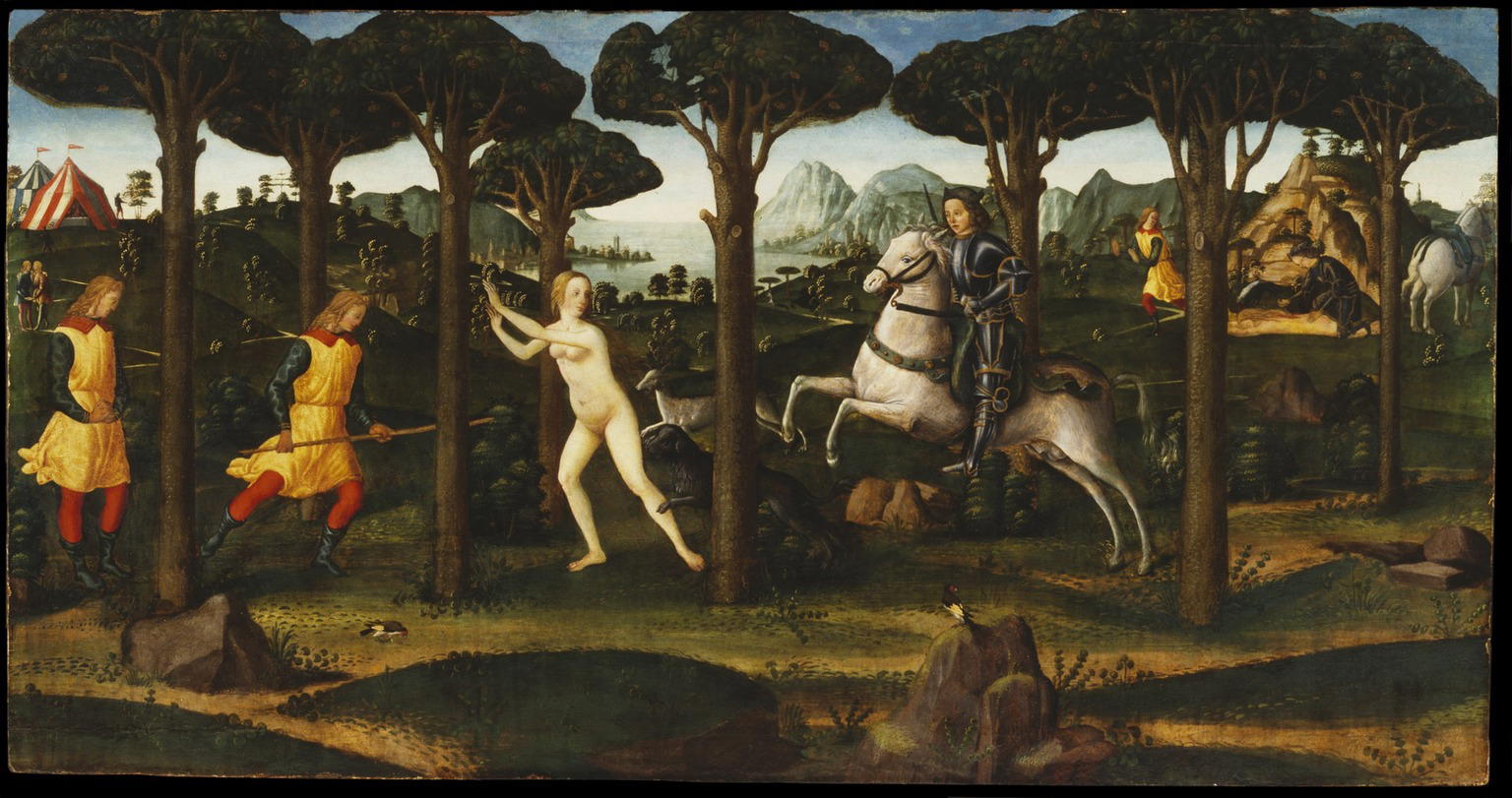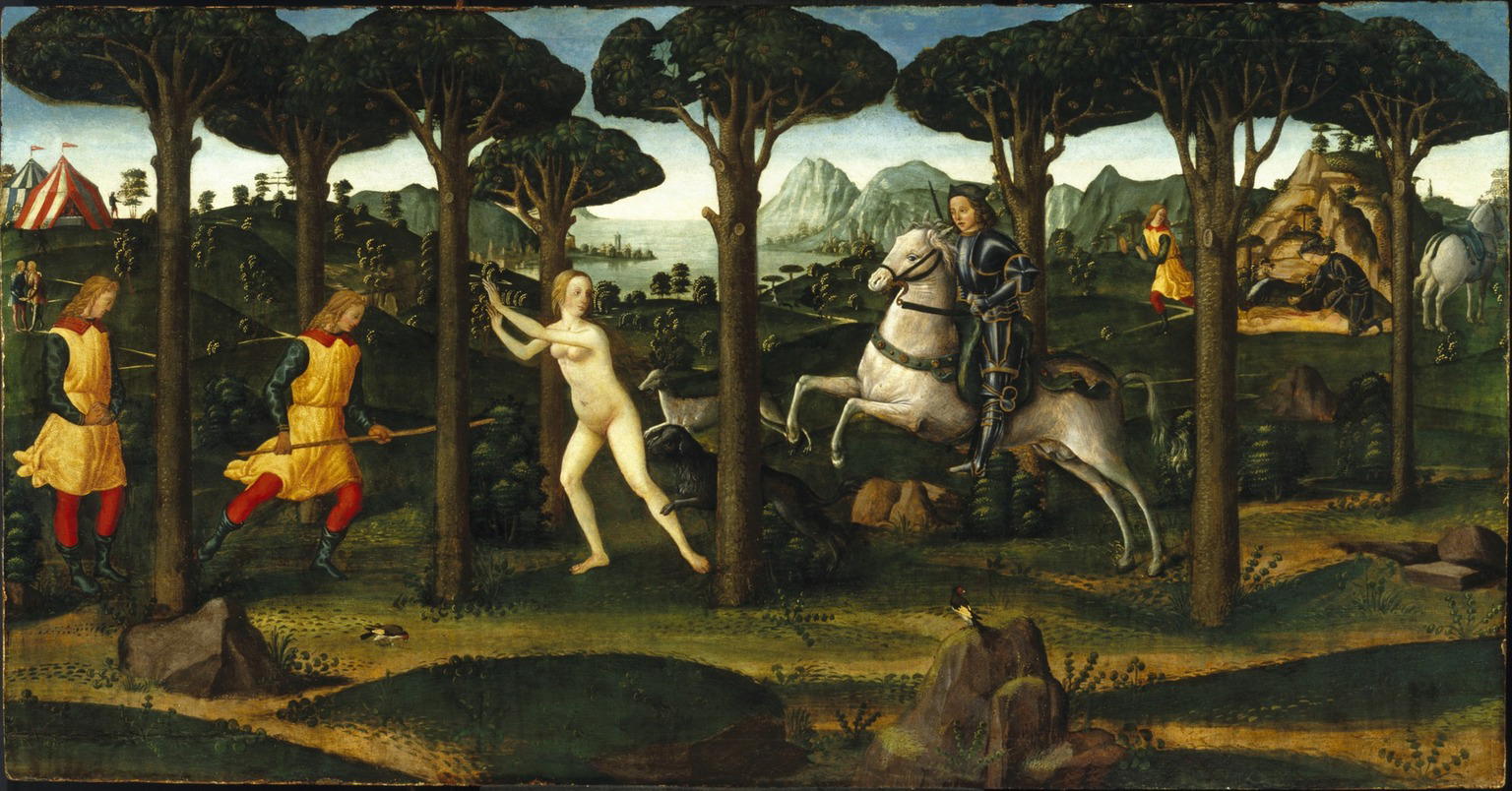Forest Scene from the Tale of Nastagio degli Onesti, in Boccaccio's "Decameron"
1 of 2
Object Label
The artist manipulates the Tuscan country-side to create a nearly symmetrical setting for a cautionary tale from Boccaccio’s Decameron (1348–51). The story tells of a reluctant bride who is hunted and slaughtered by the knight she has rejected, and then suffers the same fate each week as a ghost. The painter uses native umbrella pines to frame the characters in this human hunt. The fading blue mountains in the distance reveal the recent innovation of aerial perspective, introduced to Florence
by Leonardo da Vinci.
Caption
Davide di Tommaso Bigordi, aka Davide Ghirlandaio (Italian, Florentine, 1452–1525). Forest Scene from the Tale of Nastagio degli Onesti, in Boccaccio's "Decameron", after 1483. Tempera on wood panel, 27 1/2 × 53 in. (69.9 × 134.6 cm) frame: 36 × 62 × 3 in. (91.4 × 157.5 × 7.6 cm). Brooklyn Museum, A. Augustus Healy Fund and Carll H. de Silver Fund, 25.95. (Photo: Brooklyn Museum)
Gallery
Not on view
Gallery
Not on view
Title
Forest Scene from the Tale of Nastagio degli Onesti, in Boccaccio's "Decameron"
Date
after 1483
Geography
Place made: Italy
Medium
Tempera on wood panel
Classification
Dimensions
27 1/2 × 53 in. (69.9 × 134.6 cm) frame: 36 × 62 × 3 in. (91.4 × 157.5 × 7.6 cm)
Credit Line
A. Augustus Healy Fund and Carll H. de Silver Fund
Accession Number
25.95
Frequent Art Questions
Why do all the people look the same?
This panel is an example of a continuous narrative, a type of storytelling that illustrates multiple moments within a character's story within one visual field. This often leads to the same character appearing more than once.Tell me more.
 This panel is an example of a continuous narrative, a type of storytelling that illustrated multiple moments within a characters story in one visual field. You'll notice that the same character appears more than once.This composition depicts a few scenes from the Tale of Nastagio degli Onesti, in Boccaccio's "Decameron". In the front left, Onesti is leaving the city of Ravenna because the woman he loves rejected him. Onesti appears again encountering a knight chasing a woman through the woods.
This panel is an example of a continuous narrative, a type of storytelling that illustrated multiple moments within a characters story in one visual field. You'll notice that the same character appears more than once.This composition depicts a few scenes from the Tale of Nastagio degli Onesti, in Boccaccio's "Decameron". In the front left, Onesti is leaving the city of Ravenna because the woman he loves rejected him. Onesti appears again encountering a knight chasing a woman through the woods.En el Museo Nacional del Prado, ¿hay esta misma escena o es una copia?
 El Prado tiene tres paneles que ilustran la misma historia pero son de un artista diferente, Sandro Botticelli.La historia es lo del Nastagio degli Onesti y viene del libro Decameron de Giovanni Boccaccio. Es una collección de cientos de historias.Gracias.
El Prado tiene tres paneles que ilustran la misma historia pero son de un artista diferente, Sandro Botticelli.La historia es lo del Nastagio degli Onesti y viene del libro Decameron de Giovanni Boccaccio. Es una collección de cientos de historias.Gracias.I've seen other panels of the same story by this artist in the Prado, but in that version, there was a whole panel of the scene where the knight cuts the woman's back (seen here at the top right). Is this a second version by the same artist?
 The Prado has three panels that illustrate the same story that is illustrated by this one. However, they are not by the same artist.The work in the Prado is by Sandro Boticelli and was actually painted around the same time, 1483.AH! yes it was Botticelli (geez that sounds pretentious, sorry). I didn't know other artists had illustrated the story. Thanks.You have a great visual memory if you made the connection! The story was popular at the time: telling of a reluctant bride hunted and slaughtered by Nastagio degli Onesti after she rejects him.I love the Decameron and Renaissance art and I actually was googling that story last week! Also a new movie comedy inspired by the Decameron is just out (The Little Hours) check it out!
The Prado has three panels that illustrate the same story that is illustrated by this one. However, they are not by the same artist.The work in the Prado is by Sandro Boticelli and was actually painted around the same time, 1483.AH! yes it was Botticelli (geez that sounds pretentious, sorry). I didn't know other artists had illustrated the story. Thanks.You have a great visual memory if you made the connection! The story was popular at the time: telling of a reluctant bride hunted and slaughtered by Nastagio degli Onesti after she rejects him.I love the Decameron and Renaissance art and I actually was googling that story last week! Also a new movie comedy inspired by the Decameron is just out (The Little Hours) check it out!Can you tell me about this detail?
This work illustrates multiple moments in the same scene, telling a story from Boccacio's Decameron. In the portion you have zoomed in on, at the back-right, Onesti, who has left the city he lives in after being rejected by a woman, is seen fleeing the scene of the knight ripping out a woman's heart to feed to his dogs.Basically, the scenes we see here show Onesti confronted with a knight and the woman whom the knight pursues, creating a direct parallel to Onesti's own situation.Eventually, though this part of the story is not shown here, Onesti decides to invite the woman who rejected him, and a number of his friends, to a party in this part of the woods, where the knight and the woman (both dead) relive the horrible consequences of their disagreement on a loop.By showing the woman who rejected him this scene, Onesti convinces her not to reject him again.Thanks!!I could have sworn I saw something similar or related in the Prado Museum. What's the connection?
Good eye! There is a painting at the Prado that tells the same story, part of the story of Nastagio degl Onesti from Boccaccio's "Decameron". The Prado's version is by Sandro Botticelli, while ours is by Davide di Tommaso Bigordi, aka Davide GhirlandaioAaaaah so it's two versions of the same storyExactly! The collection of stories Giovanni Boccaccio's Decameron were popular among artists. Both works were painted in 1483, but the artists treated the scene with their own sensibilities. For instance, the moment in the background of our painting, where the knight rips out the woman's heart after killing her, isn't present in Botticelli's version.Incredible! Does your version have companion painting as well?It does, yes. The Philadelphia Museum of Art has the painting by Davide Ghirlandaio depicting the Banquet scene from the same story, when Nastagio degli Onesti invites his friends and the woman who rejected him to a banquet in the forest to watch the recurring ghostly murder of the woman you see in the version we have here.By holding the banquet and showing the woman who rejected him this scene of violence, the aftermath of a situation similar to theirs where a woman rejected the man who pursued her, he convinces her to marry him.That's amazing. Thank you for all your help and info today!Was wondering what was meant by "aerial perspective."
 Aerial perspective is the technique of representing more distant objects as fainter and more blue which was a recent innovation at the time. This technique is especially apparent in the way Ghirlandaio has depicted the far off mountains in this work.It is also known as atmospheric perspective, in reference to the effect the atmosphere has on the appearance of an object as it is viewed from a distance.Thanks, that makes sense.
Aerial perspective is the technique of representing more distant objects as fainter and more blue which was a recent innovation at the time. This technique is especially apparent in the way Ghirlandaio has depicted the far off mountains in this work.It is also known as atmospheric perspective, in reference to the effect the atmosphere has on the appearance of an object as it is viewed from a distance.Thanks, that makes sense.This reminds me of Joan of Arc.
 Ghirlandaio painted this scene from Boccaccio's Decameron about 50 years after Joan of Arc's death so the style is quite similar to those made around Joan of Arc's lifetime.A that makes sense! Thanks!
Ghirlandaio painted this scene from Boccaccio's Decameron about 50 years after Joan of Arc's death so the style is quite similar to those made around Joan of Arc's lifetime.A that makes sense! Thanks!Can you tell me why it is in the Tranquil Landscapes section? A scene of a woman being hunted doesn't seem very tranquil.
 While the content of the scene is not tranquil in the least, the composition of the landscape itself was in line with idealized paintings of landscapes in Renaissance Italy.The work utilizes single point perspective to make the vast landscape appear to exist in space. The artist has manipulated the Tuscan countryside to create a nearly symmetrical setting for this cautionary tale.Cautionary tale that women shouldn’t run away when someone wants to marry them?Cautionary in the context of the story and popular values of the time period, not that I agree that that's the lesson that should be gleaned from this by any means, especially in today's context.Ok! I, personally, might rethink the placement, given the content. But understood.
While the content of the scene is not tranquil in the least, the composition of the landscape itself was in line with idealized paintings of landscapes in Renaissance Italy.The work utilizes single point perspective to make the vast landscape appear to exist in space. The artist has manipulated the Tuscan countryside to create a nearly symmetrical setting for this cautionary tale.Cautionary tale that women shouldn’t run away when someone wants to marry them?Cautionary in the context of the story and popular values of the time period, not that I agree that that's the lesson that should be gleaned from this by any means, especially in today's context.Ok! I, personally, might rethink the placement, given the content. But understood.
Have information?
Have information about an artwork? Contact us at

